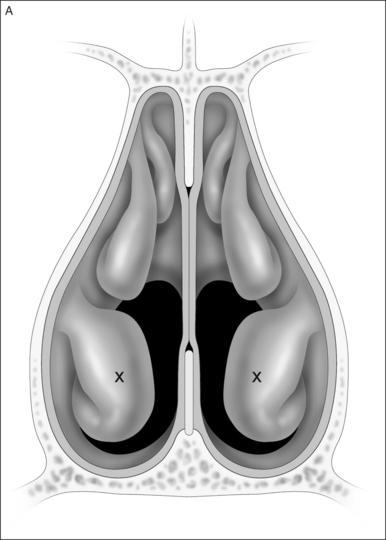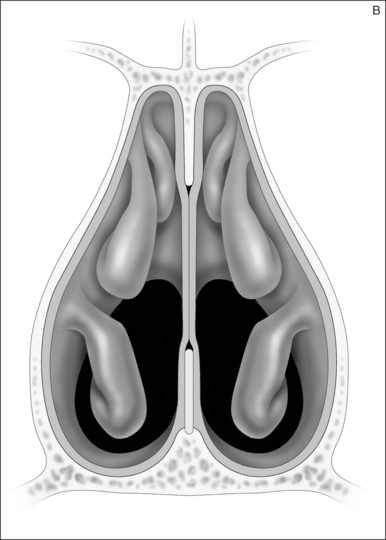Chapter 22 Radiofrequency volumetric reduction for hypertrophic turbinate
1 INTRODUCTION
Inferior turbinate hypertrophy can be caused by generalized nasal mucosal diseases in allergic and vasomotor rhinitis, as well as compensatory enlargement due to a long-standing septal deviation.1–3 Medical treatments such as topical corticosteroid sprays, antihistamines and allergic desensitization are usually the first-line therapy. However, these treatment modalities may be inadequate in achieving significant resolution of nasal obstruction. Surgical reduction of the hypertrophic inferior turbinate has been advocated after failure of medical therapy. The surgical techniques usually involve resection in the form of partial or total turbinectomy with electrocautery, scissors, or laser.4–8 Although successful outcomes following these procedures are often reported, the associated complications including pain, bleeding, crusting, dryness, infection, adhesion, foul odor and the need for nasal packing are also well known. Furthermore, most of these techniques result in mucosal injury, thus potentially affecting the nasal physiology.
Radiofrequency (RF) volumetric reduction uses RF energy to create submucosal tissue injury leading to the reduction of tissue volume. Li et al.9 first reported the use of RF for the treatment of hypertrophic inferior turbinate. This article describes the author’s technique of RF reduction for turbinate hypertrophy.
2 TECHNIQUE
| Candidates: | Any patient with hypertrophic inferior turbinates resulting in nasal obstruction. |
| Diagnosis: | Anterior rhinoscopy and possibly nasal endoscopy. |
| Facility: | Outpatient-office setting. |
| Anesthesia: | Cotton ball (saturated with 2% lidocaine without epinephrine) applied to the anterior aspect of the inferior turbinate for 1 minute followed by a local anesthetic injection (2–3 milliliters of 2% lidocaine without epinephrine). |
| Temperature: | 85 °C. |
| Energy: | 300–600 joules per lesion. |
| Tx site: | Anterior one-third to one-half of the inferior turbinate. |
| Tx number: | 1–2 lesions per turbinate. |
| Post tx: | Cotton ball applied to the puncture site for 2 minutes. |
| Post op: | No restriction, over-the-counter analgesics as needed. |
| Recovery: | Increased nasal obstruction for 2–5 days. |
| Improvement: | 10–14 days following treatment. |
2.1 DESCRIPTION OF TECHNIQUE
The procedure is routinely performed in an office setting. Treatment begins with topical anesthetic (cotton swab saturated with 2% lidocaine without epinephrine) applied to the anterior aspect of the inferior turbinate for 1 minute followed by a local anesthetic injection (3 milliliters of 2% lidocaine without epinephrine). The RF needle electrode (Gyrus Medical, Minneapolis, MN) containing a 10 mm active length is inserted 12 mm submucosally into the anterior head of the inferior turbinate (Fig. 22.1). Care should be taken not to breach the mucosa posterior to the puncture site. The settings on the RF generator include energy delivery (range 400–700 joules) and temperature (85 °C). In general, only one treatment is required per turbinate and 300–600 joules are delivered. Obviously, the amount of energy delivered is related to the size of the turbinate. Occasionally, if the turbinate is extremely large, two treatments per turbinate can be given. Immediately following the procedure, a cotton ball is applied over the puncture site for 2 minutes, and the patient is discharged without restrictions on normal daily activities. No nasal packing, topical ointment, steroids or nasal spray are required. Occasionally, patients may complain of burning sensation at the treated area. This is well managed with any over-the-counter analgesics.
< div class='tao-gold-member'>
Stay updated, free dental videos. Join our Telegram channel

VIDEdental - Online dental courses




